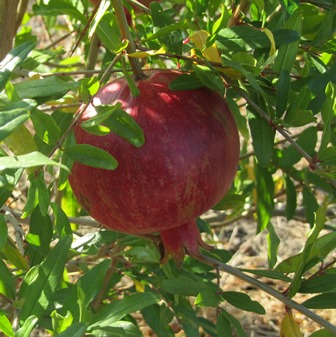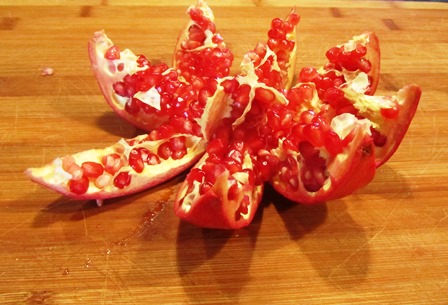De-Seeding a Pomegranate
Pomegranates are known since biblical times as a food of the gods. When ripe, the fruit’s leathery skin often splits open, exposing the red seeds inside. The fruit hangs like a jewel from a strong stem that must be cut or twisted to release the fruit.

Ripe pomegranates have a leathery outer skin, membranes thicker than oranges, but sweet, juicy seeds inside
Inside a ripe pomegranate are hundreds of juicy, sweet seeds that resemble small pegs of sweet corn. Holding the seeds in place are membranes.
The ruby red juice will stain fabrics and your fingers, so you’ll want to be careful handling the fruit as you release the seeds. The juice will stain your cutting board, too, but that stain can be removed with a lemon juice or vinegar scrub.
Cut off the stem and the blossom end.
Make a long shallow cut from the top to the bottom and up the other side, but avoid cutting deeply to avoid damaging the seeds. Then rotate the fruit and make a second cut completely around. Make 6 or 8 such shallow cuts to create equal sections.
Pry open the fruit to expose the seeds (known as arils). Place the fruit into a basin of water for 5 minutes. Working over the basin, peel the skin off and strip away the membrane pieces to release all the seeds.
Pluck out the membranes and rinse the seeds in a strainer. They are ready to be tossed into salads, eaten fresh, or stored in an airtight container (not metal) for 3-4 days. The seeds may also be made into juice; however, straining the juice from the seed pulp will be necessary.
If you keep chickens, it might interest you to know they love fresh pomegranate seeds. Seeing a ripened fruit with its peel split open and seeds exposed is a temptation for them to peck at low-hanging fruit on the tree.
 Facebook
Facebook Goodreads
Goodreads LinkedIn
LinkedIn Meera Lester
Meera Lester Twitter
Twitter




